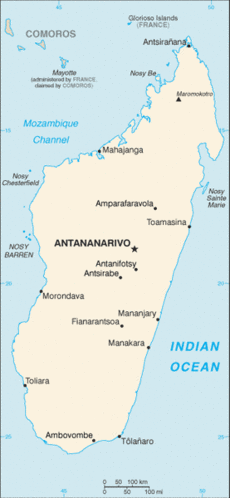Welcome to the Virtual Education Wiki ~ Open Education Wiki
Madagascar: Difference between revisions
(added cat SADC) |
(→Madagascar's HEIs in the information society: added overview) |
||
| Line 56: | Line 56: | ||
== | == Information society == | ||
Madagascar has begun to take steps towards promoting ICTs for development with the | |||
adoption of two policies: | |||
# the national ICT policy in 2004 | |||
# the economic and social development policy, the Madagascar Action Plan for 2007-2012, which promotes | |||
the expansion of ICT infrastructure and access in the country including the establishment | |||
of ICT centres in schools. | |||
The country does not have a national ICT policy for education, | |||
and the level of access to ICTs including connectivity is relatively low. | |||
There are a few initiatives in the country that attempt to promote the access and use of ICTs to support | |||
learning and teaching, but these largely assume the form of extracurricular projects. | |||
Source: http://www.infodev.org/en/Publication.413.html Source InfoDev | |||
== Virtual Campuses in HE == | == Virtual Campuses in HE == | ||
Revision as of 10:07, 30 October 2011
Partners situated in Madagascar
None.
Madagascar in a nutshell
Madagascar, or Republic of Madagascar (older name Malagasy Republic, French: République malgache), is an island nation in the Indian Ocean off the southeastern coast of Africa. The main island, also called Madagascar, is the fourth-largest island in the world, and is home to 5% of the world's plant and animal species, of which more than 80% are specific to Madagascar.
The population of Madagascar is just over 20 million.
The capital is Antananarivo.
The official languages are Malagasy and French.
Madagascar is currently divided into six autonomous provinces (faritany mizakatena), and subdivided into 22 regions (faritra), the latter created in 2004. The regions will be the highest subdivision level when the provinces are dissolved in accordance with the results of the 4 April 2007 referendum, which means in theory by 4 October 2009.
Madagascar education policy
Education in Madagascar is mandatory for the children between the age group of 6 to 14.
Madagascar education system
(sourced from http://www.mapsofworld.com/madagascar/education/)
Madagascar education includes a number of schools, colleges and universities. Madagascar education is mandatory for the children between the age group of 6 to 14.
The duration of primary education in Madagascar is 5 years. The elementary education is provided to the children of the age group between 6 to 11. The duration of secondary education in Madagascar is 7 years. The secondary education is divided into a junior secondary stage and a senior secondary stage. Children from 12 to 15 years attend the junior secondary stage and children from 16 to 18 years attend the senior secondary stage. The duration of the junior secondary stage is 4 years and for senior secondary stage, the duration is 3 years. After the completion of junior level, certificates are received by the graduates. After completing senior secondary, baccalaureat is received by the graduates. The schools of Madagascar include the American School of Antananarivo, Russian Embassy School, American High School, etc.
College professionelle is similar to the junior secondary stage and college technique is similar to the senior secondary stage.
Higher education
Universities in Madagascar
(sourced from http://en.wikipedia.org/wiki/University_of_Madagascar)
The University of Madagascar was the former name of the centralized public university system in Madagascar, although the original branch in Antananarivo is still often called by that name. The system traces its history to 16 December 1955, and the formation of the Institute for Advanced Studies in the capital Antananarivo. It quickly established itself as the main center for higher education in the country, and was renamed the University of Madagascar in 1961. The main branch opened five more branches in Antsiranana, Fianarantsoa, Toamasina, Toliara, and Mahajanga. In 1988, all branches of the system became independent of each other, and the name University of Madagascar was dropped in favor of more geography-specific titles.
Polytechnics in Madagascar
Higher education reform
The Bologna Process
Not applicable directly.
Administration and finance
Quality assurance
Information society
Madagascar has begun to take steps towards promoting ICTs for development with the adoption of two policies:
- the national ICT policy in 2004
- the economic and social development policy, the Madagascar Action Plan for 2007-2012, which promotes
the expansion of ICT infrastructure and access in the country including the establishment of ICT centres in schools.
The country does not have a national ICT policy for education, and the level of access to ICTs including connectivity is relatively low.
There are a few initiatives in the country that attempt to promote the access and use of ICTs to support learning and teaching, but these largely assume the form of extracurricular projects.
Source: http://www.infodev.org/en/Publication.413.html Source InfoDev
Virtual Campuses in HE
Interesting Virtual Campus Initiatives
None known.
Interesting Programmes
None known.
Re.ViCa Case-study
None.
Lessons learnt
None.
References
Wikipedia entries
Reports and papers
- Education in Madagascar (written in 1994), http://www.wildmadagascar.org/overview/loc/30-education.html
- Madagascar Education, http://www.mapsofworld.com/madagascar/education/
